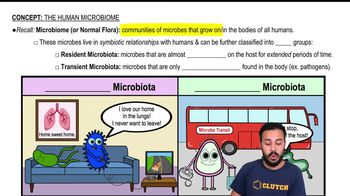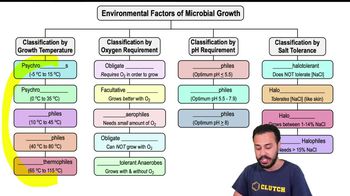By what means are helminthic parasites transmitted to humans?
 Tortora 14th Edition
Tortora 14th Edition Ch. 14+15 - Principles of Disease and Epidemiology | Microbial Mechanisms of Pathogenicity
Ch. 14+15 - Principles of Disease and Epidemiology | Microbial Mechanisms of Pathogenicity Problem 14.1a
Problem 14.1aThe emergence of new infectious diseases is probably due to all of the following except
a. the need of bacteria to cause disease.
b. the ability of humans to travel by air.
c. changing environments (e.g., flood, drought, pollution).
d. a pathogen crossing the species barrier.
e. the increasing human population.
 Verified step by step guidance
Verified step by step guidance
Verified Solution
Key Concepts
Pathogen Evolution and Disease Causation

Human Mobility and Disease Spread

Environmental Changes and Disease Emergence

Differentiate the terms in each of the following pairs:
a. etiology and pathogenesis
b. infection and disease
c. communicable disease and noncommunicable disease
Using the following data, draw a graph showing the incidence of influenza during a typical year. Indicate the endemic and epidemic levels. <IMAGE>
Use the following information to answer questions 8–10.
A Maryland woman was hospitalized with dehydration. V. cholerae and Plesiomonas shigelloides were isolated from the patient, who had neither traveled outside the United States nor eaten raw shellfish during the preceding month. The patient had attended a party before hospitalization. Two other people at the party had acute diarrheal illness and elevated levels of serum antibodies against Vibrio. Everyone at the party ate crabs and rice pudding with coconut milk. Crabs left over from this party were served at a second party. One of the people at the second party had onset of mild diarrhea; specimens from of these people were negative for vibriocidal antibodies.
The source of the disease was
a. Plesiomonas shigelloides.
b. crabs.
c. V. cholerae.
d. coconut milk.
e. rice.
Define symbiosis. Differentiate commensalism, mutualism, and parasitism, and give an example of each.
All members of a group of ornithologists studying barn owls in the wild have had
salmonellosis (Salmonella gastroenteritis). One birder is experiencing her third infection. What is the most likely source of their infections?
a. The ornithologists are eating the same food.
b. They are contaminating their hands while handling the owls and nests.
c. One of the workers is a Salmonella carrier.
d. Their drinking water is contaminated.